Hindi cinema has, over the years, borrowed liberally from English literature. Shakespeare (Hamlet, and in more recent years, Angoor, Omkara, Maqbool, and Haider), Agatha Christie (Gumnaam), Arthur Conan Doyle (Bees Saal Baad), AJ Cronin (Tere Mere Sapne): Hindi cinema seems to have drawn inspiration from a lot of authors, whether or not that inspiration has always been acknowledged or not.
Here, then, is another film derived from a literary work by a writer in the English language. Charlotte Brontë’s Jane Eyre, published in 1847, has spawned a number of cinematic adaptations (one of the first I ever saw starred Orson Welles and featured a very young Elizabeth Taylor as Helen Burns; one of my favourites stars the brilliant Toby Stephens as Rochester). In Hindi cinema, too, Jane Eyre was made into a film: Sangdil. I’ve been wanting to watch this for a while, and when recently I finally got around to reading the complete, unabridged version of Jane Eyre, I decided it was also time to watch the film.
Sangdil begins in the household of a wealthy man and his cantankerous wife (Amirbano). When we first see the wife, she’s barging into the kitchen, where a girl, Kamla (?) is hard at work scrubbing pots and pans. The woman comes in, yelling at Kamla and berating her for never doing her work properly. She examines the cleaned utensils, cannot find anything wrong with them, but manages to find a solitary spoon left behind, hidden in the ashes—and uses that as a pretext to clobber Kamla.
No; this unfortunate girl isn’t a stepdaughter. As it emerges from a conversation between this woman and her husband—who’s on the verge of dying—Kamla was his best friend’s daughter. When the friend died, he handed over not just Kamla, but all his own wealth, to this man. Kamla to be brought up well, and her inheritance to be kept safe for when she grew up.
Now, realizing how his wife’s treating Kamla, the man is getting worried. What will happen to Kamla when he’s gone?
Kamla is not completely friendless in this household, though. The man’s son, Shankar (?) is a good friend, as is the kindly Dhaayi Maa (Leela Chitnis, for once looking young and fresh-faced). Whenever they’re able to, Shankar and Kamla escape to Dhaayi Maa’s room to have her tell them tales of princes on white horses coming to the rescue of captive princesses beleaguered by ugly witches.
This joy, sadly, is short-lived. One day, Shankar’s father is in such a poor way that he calls for the family mandir to be brought to his bedside: he wants to draw solace from it. He also calls for Shankar and Kamla, and exhorts Shankar: after his (the father’s) death, Shankar must look after Kamla, and must make sure, too, that his mother is not able to touch Kamla’s inheritance.
Shankar’s mother happens to come in just then, and hearing this humiliating piece of advice, throws a tantrum. The end result of which is that Shankar’s father cops it…
… and, a few days down the line, Shankar’s widowed mother sends for a stern-looking man to take Kamla away, to be brought up in an ashram he runs. Kamla barely has time to say goodbye to Shankar and take a flower from the household shrine before the man (who tells her that he’s heard she’s a very wicked girl, but will have to now mend her ways) bundles her into a horse-drawn coach in which he’s come.
Kamla, no wimp, realizes that she’s headed for worse than Shankar’s mother, so—while the man falls asleep in the coach—she looks out over the passing countryside. Seeing three monks walking down the hill below the coach, she carefully opens the door and flings herself out. The monks pick her up and take her to the religious house of which they are members. This place is dedicated to the worship of Shiva (referred to, in this film, throughout as Shankar) and is presided over by the Badi Maa (Protima Devi, looking interestingly yogini-ish with flowers encircling a topknot, and much gauzy stuff).
When Kamla comes to, Badi Maa asks her if she, too, would like to dedicate her life to the worship of Shankar [Hah! Considering Kamla’s childhood sweetheart is called by that name—and childhood sweethearts always grow up to be sweethearts still—we know where this is headed]. Kamla, noting the quiet gentleness of Badi Maa and everybody else around, throws in her lot with them.
The next time we see Kamla, she’s the centre of attention at a havan of some sort, sitting all decked up in front of a sacred fire. Badi Maa instructs Kamla to put all her worldly belongings—the clothes she had been wearing when they had found her—into the sacred fire. Leave behind all trappings of the world, she is told. Kamla obeys, but clenched in her fist, hidden behind one leg, she keeps one small reminder of her earlier life: the flower she had taken from the shrine back at Shankar’s home.
Years pass, and Kamla (now Madhubala) is a pujaaran (priestess), singing hymns to Shankar [which Shankar, she knows well enough]. One day, the Badi Maa informs Kamla that they have been invited to visit a country mansion, where the annual harvest festival is celebrated with a pooja of the Goddess of Plenty, Annapurna. Kamla and Co. will be performing the pooja.
While they leave, the scene shifts to a plush, fashionable home where a wealthy young Thakur (Dilip Kumar) is flirting with his beloved, Mohini (Shammi). There is a marked cynicism in his tone, but he flirts on, telling Mohini how beautiful she is and so on and so forth. And Mohini is adept at flattering him as well.
This romantic [yet oddly unromantic, too, since there’s something so cold and calculating about it] interaction is suddenly interrupted. A somewhat wild-looking man (Anwar Hussain) arrives, and the Thakur hurries away to meet him. There’s some mystifying conversation between them—the visitor making some vague threats, the Thakur not letting himself being bullied. The Thakur mentions that he is going away to his jaagir (his estates) for some time. Also going with him on this excursion will be Mohini and some of their friends: a house party.
Meanwhile, Kamla and Badi Maa arrive, with their entourage, at the country house where they’ve been invited. Kamla is taken aback on being greeted by the lady of the house (Leela Chitnis), who, they’re told, is the Thakurain—the mother of the Thakur whose house this is. Kamla’s astonishment is noticed by Badi Maa, who asks about it. ‘She looks just like our maidservant from when I was a child,’ Kamla admits, but Badi Maa brushes it off as mere coincidence. Surely there can be more than one person with the same face? [And who would know that better than someone in Hindi cinema?]
Things begin happening almost immediately. The Thakur arrives, and Kamla’s first glimpse of him is as he’s riding through the woods—where she’s sitting, contemplating the scenery. He, in trying to pluck a flower while still on horseback, falls off, and Kamla goes to his rescue. Far from being grateful for her help, the Thakur is distinctly brusque.
…and, later, when he sees her in his house (and she’s startled, to find this man the Thakur), he is even more rude. ‘Is this a temple or a home?’ he asks the Thakurain, his ‘mother’. ‘You keep filling it up with these priests and whatnot.’ Kamla is puzzled, and intrigued too.
As the days leading up to the harvest festival go by, odd things happen. Kamla, who has been lodged upstairs, wakes up one night to eerie howls and screams. She is, understandably, scared, and hurries out into the corridor to try and discover what it is. There, she meets the Thakurain, who tells her that it is a ghost. The house has its own resident ghost, which begins screaming every now and then and will only be silenced when she has seen the master of the house—
And there, coming down the stairs, is the Thakur, with one shirtsleeve ripped and his arm streaming blood. Kamla is horrified—what is this?—but cannot find much to say. Especially as the Thakur’s abrupt questions—What is she doing out here? Why isn’t she in her room?—make it clear that her curiosity is not welcome.
The relationships between the Thakur and Kamla on the one hand and Mohini on the other, begin to develop. Kamla sees how Mohini and the Thakur behave towards each other, and realizes that this is no true love. Kamla herself is surprised by the Thakur’s odd behaviour towards Kamla: sometimes he is brusque to the point of rudeness, sometimes chatty (if in a cynical way), and sometimes downright baffling—for instance, on one of their first meetings, he looks closely into her face and tells her how beautiful she is—and how much he hates beautiful faces.
Then, one night, Kamla hears those screams again, and this time goes out—to find that the Thakur’s bedroom has been opened and his large bedstead set aflame, with the Thakur still asleep in it. Kamla wakes him up, and helps put out the fire by pouring water on it (and the Thakur, who for once thanks her, though in an amused way). The Thakur searches among the debris in his room, and picks up one thing, which he clutches to himself: a small idol of a deity. Kamla immediately recognizes it: this was an idol which used to reside in the little household shrine when she was a child; it had, shrine and all, been taken by Shankar just before she left home. The Thakur is Shankar!
Mohini comes in, and is suspicious: what is this pujaaran doing in the Thakur’s room? Shankar tells her what had happened, but Mohini is unimpressed. She shoos Kamla away, and Kamla—still dazed from this realization, that the boy-turned-man she has cherished all these years is actually the Thakur, returns to her room. But what has happened to him? she wonders. Why has Shankar—the Shankar who was so sweet and kind as a child—become thus, bitter and cynical, allowing himself to be led astray by a woman who is so obviously no good?
And those, of course, aren’t the only questions, even if Kamla isn’t asking them right now. Who, for example, is that strange man who had met Shankar in the earlier scene and who has put in another brief appearance since, to break a window? What is the secret of the ghost whose screams will only be silenced if Shankar appears?
A good film, an interesting blend of romance, suspense, and tragedy, and a fairly decent adaptation of Jane Eyre.
What I liked about this film, and comparisons to the book:
I’m clubbing these two sections together, because what I liked about the film often overlaps with comparisons to the book.
First off, though, stuff that’s specific to the film: the fact that Madhubala and Dilip Kumar look so good (and have such great chemistry). Dilip Kumar’s acting, which is—as always—brilliant. He manages to very effectively portray the turmoil and angst of a man who knows he is pursued for his wealth, and who harbours a deep bitterness towards those who have reduced him to these circumstances. Yet, too, a man who is capable of love, and that too a deeply passionate, affectionate love. This is a well-etched character, a good Indian equivalent of Edward Rochester, and Dilip Kumar plays the role well, without melodrama.
Then, the music, by the much-overlooked Sajjad. My favourite song from the film is the lovely Talat solo, Yeh hawa yeh raat yeh chaandni, followed closely by Dil mein samaa gaye sajan, but Dharti se door gore baadlon ke paar is sweet too.
What fascinated me were the changes made to the plot to make it an adaptation acceptable to Indian audiences. The first few scenes—until Kamla grows up and goes to Shankar’s jaagir—are nothing like what happens in the book, but it’s far shorter. Which, on looking back, I see as a good way of shortening the story to suit the length of the film (and really, if the focus of the film is on the female protagonist and her relationship with the man in her life, then the depiction of her early life can be somewhat dispensed with). The bulk of the really interesting plot happens in the second half of the book, and that is where Sangdil is relatively faithful to the original—down to characters like Mohini (Blanche Ingram in the book), the Anwar Hussain character (Mason), and even, to some extent, Dhaayi Maa (Mrs Fairfax).
Where it does make concessions is in catering to Indian sensibilities. For a hero to be bringing up a little girl whom he has been told may be his daughter (by a now-dead courtesan) would not do; so there is nothing of an Adele in this film. And, since the love story between Rochester and Jane Eyre develops over the course of a few months—and Sangdil doesn’t have the luxury of that—it gives a good reason for Shankar and Kamla to fall in love fairly quickly once they recognize each other: they have been childhood sweethearts.
Also, while the St John Rivers—missionary angle (and Jane Eyre’s becoming an heiress) is completely omitted from Sangdil, there’s her role as a pujaaran to compensate. Kamla’s commitment (or lack of it) to the sect in which she’s been brought up acts as a counterbalance to her love for Shankar, and becomes the force towards which she is drawn—until.
What I didn’t like:
The very hurried end. True, I had been hoping to see something along the lines of a St John dilemma develop, but I could see why this would be impractical in a film-length structure (possibly not too difficult to manage in a TV series). However, the end here—even without a St John angle to it, is just so sudden that it appears contrived.
Still, though, a good adaptation of Jane Eyre, especially the more Gothic elements and the tormented hero trope.


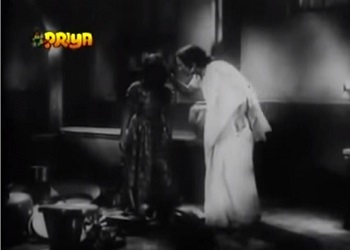



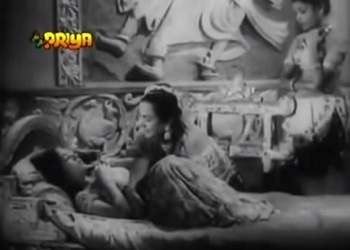

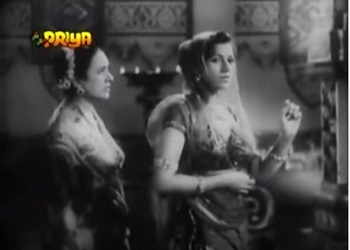
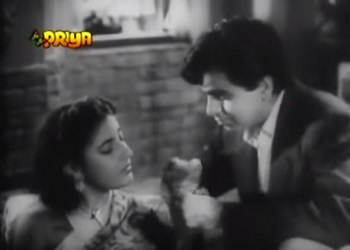


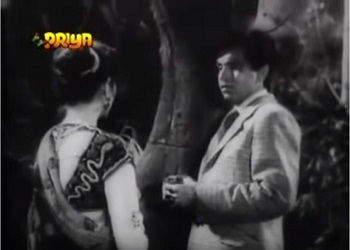
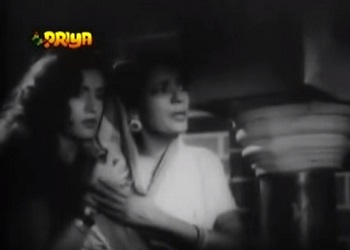
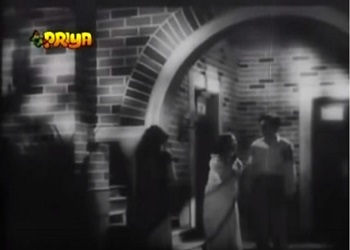
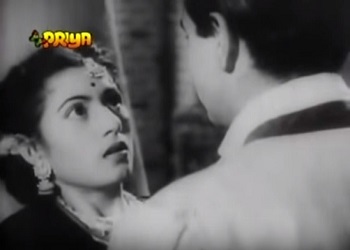
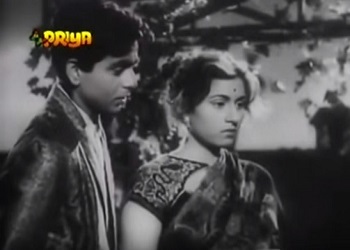
This is one of the book adaptations that I really liked. For one, they Indianised it quite sensibly; secondly, Dilip was a joy to watch. When that man got it right, he got it exceedingly so. And his chemistry with Madhubala was amazing. They really were made for each other, that pair. Of course, Sajjad’s music! Apart from the songs you mentioned, Darshan pyaasi, aayi daasi which, to me, ranks as one of Geeta’s best.
Your review makes me want to watch it again.
LikeLike
Yes, I thought the Indianisation was sensibly done – and to the extent that it worked. No unnecessary addition of a silly comic side plot and stuff, just to make it more acceptable to Indian audiences (though since this was back in 1952, when the CSP was less integral to Hindi film plots, perhaps that’s not surprising).
Yes, Darshan ki pyaasi is nice too. And Madhubala is just so gorgeous! :-)
LikeLike
I enjoyed Sangdil when I saw it many years ago. However I found it didn’t stand up too well to repeat viewings. While it’s a reasonably faithful adaptation of the book, the inescapable compromises necessary to make a commercially successful Hindi film (mentioned by Madhulikajee in her post) jarred more than any deviation from the book. After all, directors have always taken liberties while adapting books for the screen. I wonder if it was because I’d seen the Orson Welles-Joan Fontaine version of Jane Eyre before Sangdil that I felt an undercurrent of dissatisfaction while watching the latter. When I saw it the second and third times, it was Sajjad’s music, Dilip Kumar’s histrionics, and, of course, Madhubala that held my interest, rather than the film as an organic whole. I must confess, though, that seeing Dilip Kumar sing Ye hawa, ye raat, ye chaandni to Shammi rather than Madhubala was a huge let-down. :)
LikeLike
I happened to have seen Yeh hawa yeh raat yeh chaandni many, many years ago – back in the 80s, on Chitrahaar – so I knew Dilip Kumar sang it to Shammi rather than to Madhubala, so I was prepared for that. ;-)
That’s an interesting thing you mention about the film not holding up to repeat viewings. I suppose, at least this first viewing for me was more prompted by curiosity: I wanted to know how they would translate the novel to the screen, what changes they would make (because there are aspects of the book that would be difficult to Indianise – like the St John angle). I was disappointed to find that bit of the novel completely cut out and the end hurried along so, but for a one-time watch, while it may not be a faithful adaptation of Jane Eyre, I thought it was an engrossing film nevertheless. Will have to watch it a couple of times more to see whether it holds up or not!
LikeLike
I am quite a fan of “Jane Eyre” – have seen so many versions of the film – the first one I saw was the Tamil adaptation – and that was before I read the original book. The Tamil adaptation called “Shanthi Nilayam” is a combination of “The Sound of Music” and “Jane Eyre” – so that the heroine comes to the house as a governess to a host of kids. I saw it when I was just 9 or 10 years old and was terrified by the woman in the attic. The fear lasted for a few years. I have seen some of the Hollywood adaptations but have more to watch – am very fond of the book, so I have to watch all of them if I can :-)
But coming to “Sangdil”, I enjoyed the film – thought it was choppy – the Madhubala/Dilip Kumar chemistry as you mentioned was superb. As adaptations go, it is not bad at all and captures the dark/gothic undertones of the original. The Tamil version fails on that count because of the peppy governess portion. The melodrama in the Hindi version is still more over-the-top than I would like. And the religious component in “Jane Eyre” is actually quite lovely – the sharing of her weath, her forgiveness of Mrs Reed. I know it is hard to bring it all together in a film, but I would have preferred that to be woven into the film. The film (from my recollection) is a bit dated, but I still liked it. Maybe I should watch it again to see what I think about it now.
And the music in “Sangdil” is BRILLIANT. My absolute favorite song is “Woh to chale gaye ae dil” though there are so many nice ones in the film including the ones you mention and the Asha/Geeta duet.
Speaking of Dilip/Madhubala films, have you seen “Amar”? Extremely unusual film for its time. Though you have to put up with a terribly over-the-top Nimmi. I saw these 2 films very close to each other and remember liking both of them since they seemed to be quite well made given the other films of that period.
LikeLike
Ah, I hadn’t known Jane Eyre was remade in Tamil as well. And with a The Sound of Music angle thrown in too. That sounds ambitious…
You’re right, the religious element of the novel, and of Jane Eyre actually finding herself an heiress and battling with her own conscience about going to India as a missionary etc, is an important part of the novel. I suppose, though, that that (or whatever plausible Indianised version could have been made of that) was cut out because of lack of time – it would probably have required a good half hour’s worth of screen time to set up a secondary male lead of the St John type.
Yes, I’ve watched (and reviewed, on this blog) Amar. An unusual film, I thought, and I more or less liked it, except for Nimmi, who really got on my nerves.
LikeLike
I need to read the book! And then see the film to appreciate how it has been Indianised.
At this point all I can think of is how pretty Shammi looks. I guess associating her with the archetypal film mother or aunt is too deeply ingrained in my mind.
LikeLike
Yes, Shammi was really quite pretty in her early films. :-)
Do read the book and watch the film – it’s one of the few Hindi film adaptations of well-known European works that I think stands up fairly well to the original, even though there have been some major plot elements changed or simply removed.
LikeLike
I just realised that I haven’t read Jane Eyre. We’d a chapter in our English book in the school, which had a small part of Jane Eyre and since then I always assumed, I’ve read it.
Sangdil sounds to be good. I’ve to watch it sometime. Do you think I should read the book first?
Thanks for the review.
LikeLike
It’s really up to you whether you’d like to read the book before you watch it or not – though I think reading the book would be a good idea, since it’ll help you appreciate the changes that have been made to adapt it (plus, reading Rochester’s character and then seeing how Dilip Kumar plays him was something I found particularly satisfying). :-)
Glad you liked the review, Harvey! Thank you.
LikeLike
Madhu,
I had some unflattering notions about Dilip Kumar’s ‘tragedies’ (Devdas excepted). Some seemed surprise or unnecessary tragedies, because they could as well have happy ending without any loss of merit – ‘Jugnu’ (1947) for example. Your excellent review made me overcome my hesitation. Watched it after reading your review. Had I not known that it was based on a book, my first instinct would have been again ‘unnecessary’. Most tragedies have a reason: overweening ambition, or a fatal flaw or arrogance etc. Here Dilip Kumar is an innocent victim. How do we understand it? One is that in Gothic novels some dark things happen without a reason. Or we go back to Oriental thought – he was paying for his mother’s sins.
A surprise was Shammi’s larger presence in major part of the film. I thought Kuldip Kaur or Cuckoo would have been better. Shashikala was made to order for such roles, but she became big in later years.
Now I have to read the book again.
AK
LikeLike
I have to admit I haven’t seen Jugnu yet, but I know what you mean – in fact, when I was watching Sangdil, that was what struck me as well: that Dilip Kumar ended up doing so many films with unnecessarily tragic endings. Not that that happened in Sangdil, or even that Sangdil had him playing a melancholy character – far from it. In fact, I thought he played the ‘Rochester’ part well, melding the half-brusque and cynical man with the romantic one very well (though, since no Hindi film hero can be as degenerate or the young Rochester admitted himself to be, here in this film, he’s been forced into the marriage by his mother). I like your point about him possibly ‘paying for his mother’s sins’ – that hadn’t occurred to me.
Yes, it did surprise me to see Shammi in such a big role. I’m guessing this must have been one of her earliest films? I too would have expected a Kuldeep Kaur or a Cuckoo as Mohini (though Kuldeep Kaur does seem tailormade as the mad wife!). Shashikala would’ve fitted the role perfectly, though you’re probably right about the timing. The earliest film of hers that I’ve seen is Aab-e-Hayat, which dates to 1955, and had her as heroine.
LikeLike
Madhu,
Shashikala happens to be present in Jugnu too. She is also there in the iconic qawwali Aahein na bhari shikwe na kiye in Zeenat (1945). But her vamp is probably a much later development.
AK
LikeLike
I find it interesting, though, that Shashikala shifted easily from one type of supporting heroine to another around the same time: for instance, in films like Sujata, Anupama, Junglee and Gumraah, she’s in a sympathetic role – while around the same time, also acting the vamp in films like Nau Do Gyarah or Apne Hue Paraaye.
LikeLike
Quite liked this article, thanks. I haven’t seen Sangdil but mean to do so now. By the way, you could add Mausam (1975) to your list in the first paragraph. It is based on The Judas Tree by Cronin.
LikeLike
Thank you! I hadn’t known Mausam was based on an AJ Cronin novel too.
LikeLike
First I have to read Jane Eyre again. Sigh ! That was my first thought when I started reading your review. I had been wanting to watch Sangdil for a long time, ever since I saw the songs on Youtube . I had always liked the music. I had no clue what the movie was about. I will definitely watch it, your review gives such a neat picture of the film. Dilip Kumar and Madhubala together, all the more reason. So, I think I will watch the movie first ( less time ) and then read the book. Read it in high school and have forgotten the details. Books are always better than their screen adaptation, but thanks for your review, the movie sounds pretty good too.
LikeLike
Yes, Neeru: the movie is pretty good, though people who’re sticklers for getting everything from a book into a movie – or even close to everything – may disagree, since a large portion of the plot has been cut out. That said, I thought they did a good job of translating it into an Indian milieu and tailoring it to Indian sensibilities.
Do give it a try, and tell me what you think of it.
LikeLike
I haven’t seen the movie but it appears to be a good one, based on your review Madhu. I do have mixed reaction to Dilip saheb though. I am not a big movie buff so I can’t say with confidence but I find him repeating himself across the varied movies he has acted in. Or may be it’s my lack of recognizing great acting – I feel he is the same soul who has played many roles but he still feels like Dilip Kumar. I can’t say the same about some of the other great actors who sorta lived the roles they played.
Madhubala looks her usual stunning self, always! I don’t know how it’s possible for anyone to get close to her legacy!
I like the song “Dil main samaa gaye sajan”, a lot!
LikeLike
“I find him repeating himself across the varied movies he has acted in.”
I think I know what you mean, though I find that in films drastically different from the usual Dilip Kumar film – like Kohinoor (barring the last half hour or so) and Azaad, he can be quite different. I do think that in a lot of the more tragic roles he did – like Devdas, Deedaar, Andaaz, Daag and so on – he tends to get repetitive. Then, there’s also the fact that there was a certain expectation of Dilip Kumar. From what my father tells me, people went to see a Dilip Kumar movie expecting to see Dilip Kumar in a particular style – and if they didn’t get it, they weren’t happy. My father still recalls that when Aan was released, Dilip Kumar drew a lot of flak for having done ‘such a frivolous role’!
LikeLike
Sure, there was that image thing but aren’t the artists sorta responsible for creating that image and then become victim of their own success. That is, if you subscribe to this theory. May be they like to keep this image. The real artists in my opinion are the ones who can really play the role as the story requires; like the Balraj Sahni’s of the world.
We have seen this happen to too many of our stars – Dilip Kumar, Rajesh Khanna, Raj Kumar to name a few..
I do need to see this movie since your review clearly says that this one has drastically different version of Dilip Kumar and not the one we are more accustomed to.
LikeLike
“That is, if you subscribe to this theory.”
I agree completely. It happens to a lot of actors – even now. They reach stardom on the basis of some success in a particular type of role, and then that becomes their defining style. Soon, you have Dev Anand never playing a character, but always playing Dev Anand. And it seems that’s what most people, after a while, start expecting – even demanding – of stars. Which is such a pity, because it kills their acting skills.
Yes, do try this film: it’s a different Dilip Kumar. Not terribly different, but yes: certainly not the weepy and put-upon Dilip Kumar of several of his more popular films.
LikeLike
Who are the child artists in this film?
LikeLike
No idea. That’s why I’ve left question marks in front of their names; for the actors I can identify, I always write the names after the names of the characters they’re playing.
LikeLike
The best part I liked is the lyric, the tune,the ambience , and the display of love in acting
By Shammi and Dilip Saab. It did not look artificial love as being described, but as true,deep, heart to heart , even if passionate.
LikeLike
I never knew that this film was an adaptation of Jane Eyre until I read your post.
I guess this gives Dilip Kumar the rare distinction of starring in two separate films based on two separate Brontë sisters’ works: Charlotte’s Jane Eyre first and Emily’s Wuthering Heights later on, with Dil Diya Dard Liya.
LikeLike
That hadn’t occurred to me, either! Interesting.
Though I’ve heard about Dil Diya Dard Liya often enough, I’ve never got around to watching it. As it is, Wuthering Heights isn’t one of those frothy books I want to read again and again, and someone dd mention that Dil Diya Dard Liya wasn’t too good. Have you seen it?
LikeLike
I saw it many years ago. I don’t recall it being a particularly good film either. It increases the novel’s innate melodrama by several levels to suit melodrama lovers of the 60s. The actors do try to make it worthwhile – Dilip, Waheeda, Rehman, Pran are dependable players – but it’ still a slog. To top it, Wuthering Heights is far too revered a literary epic to shoehorn a happy ending to it. It’s one of those things that’s just not done.
Only Naushad – Shakeel Badayuni’s music is sublime, as usual.
LikeLike
“To top it, Wuthering Heights is far too revered a literary epic to shoehorn a happy ending to it. It’s one of those things that’s just not done.”
Now you’ve made me curious. I cannot imagine Wuthering Heights with an outright happy end – the nearest element to it is the Hareton Earnshaw-Catherine Jr romance.
But yes, the music of Dil Diya Dard Liya is superb, so I might just watch it for that (and because I do like the cast). Let’s see…
LikeLike
Talking of broads,i would anyday prefer the realistic saga of Juana Roca and Val Cade,to the nagging tales of Catherine and Heathcliff or Jane Eyre.J.H.Chase created a far superior classic of lust and passion with his ‘CADE’ than those prudish bronte sisters could dare to imagine with their tiny grey matter.The dainty yet very competent Karamaneh,that slave of despicable FuManchu is another gal to my liking,though Dr.Petrie has first claim.Hey! I would be very happy with the Saint’s moll,Patricia Holm,even for a few days,just to prod him to be sensitive towards his first love.Mark Girland and James Bond,however were very smart to warn their chicks that they were drifters and won’t go beyond the first date.
LikeLike
For some reason Sangdil isn’t showing up as a link on your Hinf Films Reviewed list. I found it by searching however.
LikeLike
Thanks for alerting me to that. Have corrected it.
LikeLike